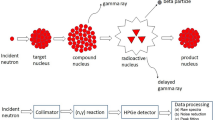Abstract
Prompt gamma ray activation analysis (PGAA) is a non-destructive nuclear measurement technique that quantifies isotopes present in a sample. Here, we use PGAA spectra to train different types of models to elucidate how discriminating these spectra are for various classes of materials. We trained discriminative models for closed set scenarios, where all possible material classes are known. We also trained class models to address open set conditions, where this enumeration is impossible. After appropriate pre-processing and data treatments, all such models performed nearly perfectly on our dataset, suggesting PGAA spectra may serve as powerful nuclear fingerprints for robust material classification.









Similar content being viewed by others
Data availability
Data available from authors upon reasonable request.
References
Eftekhari-Zadeh E, Feghhi SAH, Roshani GH (2017) Hybrid combination of multi-layer perceptron and neutron activation analysis in cement prediction. Pramana—J Phys. https://doi.org/10.1007/s12043-016-1327-2
Nunes WV, Da Silva AX, Crispim VR, Schirru R (2002) Explosives detection using prompt-gamma neutron activation and neural networks. Appl Radiat Isot 56:937–943
Hossny K, Hossny AH, Magdi S, et al (2020) Detecting shielded explosives by coupling prompt gamma neutron activation analysis and deep neural networks. Sci Rep. https://doi.org/10.1038/s41598-020-70537-6
Vaze S, Han K, Vedaldi A, Zisserman A (2021) Open-set recognition: a good closed-set classifier is all you need? arXiv:2110.06207
Geng C, Huang S, Chen S (2018). Recent advances in open set recognition: a survey. https://doi.org/10.1109/TPAMI.2020.2981604
Dietterich TG, Guyer A (2022) The familiarity hypothesis: explaining the behavior of deep open set methods. Pattern Recogn. https://doi.org/10.1016/j.patcog.2022.108931
Yang J, Zhou K, Li Y, Liu Z (2021) Generalized out-of-distribution detection: a survey. arXiv:2110.11334
Forina M, Oliveri P, Lanteri S, Casale M (2008) Class-modeling techniques, classic and new, for old and new problems. Chemom Intell Lab Syst 93:132–148. https://doi.org/10.1016/j.chemolab.2008.05.003
Oliveri P (2017) Class-modelling in food analytical chemistry: development, sampling, optimisation and validation issues—a tutorial. Anal Chim Acta 982:9–19. https://doi.org/10.1016/j.aca.2017.05.013
Mahynski NA, Monroe JI, Sheen DA, et al (2023) pgaa-material-authentication. https://github.com/mahynski/pgaa-material-authentication. Accessed 9 Feb 2023
Mackey EA, Paul RL, Lindstrom RM et al (2005) Sources of uncertainties in prompt gamma activation analysis. J Radioanal Nucl Chem 265:273–281
Pedregosa F, Varoquaux G, Gramfort A et al (2011) Scikit-learn: machine learning in python. J Mach Learn Res 12:2858–2830
Nadeau C, Bengio Y (2003) Inference for the generalization error, pp 239–281. https://doi.org/10.1023/A:1024068626366
Bouckaert RR, Frank E (2004) Evaluating the replicability of significance tests for comparing learning algorithms. Lect Notes Comput Sci (Includ subser Lect Notes Artif Intell Lect Notes Bioinformat) 3056:3–12. https://doi.org/10.1007/978-3-540-24775-3_3
Wainer J, Cawley G (2021) Nested cross-validation when selecting classifiers is overzealous for most practical applications. Expert Syst Appl 182:115222
Lemaitre G, Nogueira F, Aridas CK (2017) Imbalanced-learn: a python toolbox to tackle the curse of imbalanced datasets in machine learning. J Mach Learn Res 18:1–5
Chawla N, Bowyer KW, Hall LO, Kegelmeyer WP (2002) SMOTE: synthetic minority over-sampling technique. J Artif Intel Res 16:321-357
Vandeginste BGM, Massart and DL, Buydens LMC, et al (1998) Analysis of measurement tables. In: Handbook of chemometrics and qualimetrics: part B. Elsevier, pp 87–160
van den Berg RA, Hoefsloot HCJ, Westerhuis JA et al (2006) Centering, scaling, and transformations: improving the biological information content of metabolomics data. BMC Genom 7:1–15
Wang Y, Huang H, Rudin C, Shaposhnik Y (2020) Understanding how dimension reduction tools work: an empirical approach to deciphering t-SNE, UMAP, TriMAP, and PaCMAP for data visualization, pp 1–63. arXiv:2012.04456
Kluyver T, Ragan-Kelley B, Pérez F et al (2016) Jupyter Notebooks - a publishing format for reproducible computational workflows. In: Loizides F, Schmidt B (eds) Positioning and power in Academic Publishing: players, agents and agendas. IOS Press, pp 87–90
Waskom M (2021) Seaborn: statistical data visualization. J Open Sour Softw 6:3021. https://doi.org/10.21105/joss.03021
Reback J, McKinney W, et al (2022) Pandas-dev/pandas: Pandas 1.4.3. 10.5281/zenodo.6702671
McKinney W (2010) Data structures for statistical computing in python. In: Proceedings of the 9th python in science conference, vol 1, pp 56–61. https://doi.org/10.25080/majora-92bf1922-00a
Mahynski NA (2022) pychemauth. https://github.com/mahynski/pychemauth. Accessed 9 Feb 2023
Kemsley EK, Defernez M, Marini F (2019) Multivariate statistics: considerations and confidences in food authenticity problems. Food Control 105:102–112. https://doi.org/10.1016/j.foodcont.2019.05.021
Rodionova OY, Titova AV, Pomerantsev AL (2016) Discriminant analysis is an inappropriate method of authentication. TrAC—Trends Analyt Chem 78:17–22. https://doi.org/10.1016/j.trac.2016.01.010
Rodionova OY, Oliveri P, Pomerantsev AL (2016) Rigorous and compliant approaches to one-class classification. Chemom Intell Lab Syst 159:89–96. https://doi.org/10.1016/j.chemolab.2016.10.002
Pomerantsev AL, Rodionova OY (2014) Concept and role of extreme objects in PCA/SIMCA. J Chemom 28:429–438. https://doi.org/10.1002/cem.2506
Pomerantsev AL (2008) Acceptance areas for multivariate classification derived by projection methods. J Chemom 22:601–609. https://doi.org/10.1002/cem.1147
Pomerantsev AL, Rodionova OY (2018) Multiclass partial least squares discriminant analysis: taking the right way—a critical tutorial. J Chemom 32:1–16. https://doi.org/10.1002/cem.3030
Breiman L (2001) Random forests. Mach Learn 45:5–32
Acknowledgements
Certain equipment, instruments, software, or materials, commercial or non-commercial, are identified in this paper to specify the experimental procedure adequately. Such identification is not intended to imply recommendation or endorsement of any product or service by NIST, nor is it intended to imply that the materials or equipment identified are necessarily the best available for the purpose. Contribution of the National Institute of Standards and Technology, not subject to US Copyright.
Author information
Authors and Affiliations
Corresponding author
Ethics declarations
Conflict of interest
The authors have no relevant financial or non-financial interests to disclose.
Additional information
Publisher's Note
Springer Nature remains neutral with regard to jurisdictional claims in published maps and institutional affiliations.
Supplementary Information
Below is the link to the electronic supplementary material.
Rights and permissions
About this article
Cite this article
Mahynski, N.A., Monroe, J.I., Sheen, D.A. et al. Classification and authentication of materials using prompt gamma ray activation analysis. J Radioanal Nucl Chem 332, 3259–3271 (2023). https://doi.org/10.1007/s10967-023-09024-x
Received:
Accepted:
Published:
Issue Date:
DOI: https://doi.org/10.1007/s10967-023-09024-x




